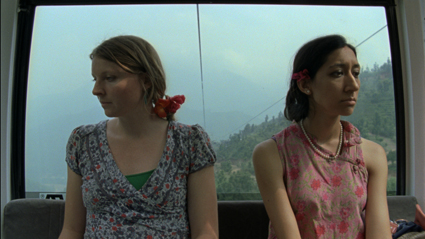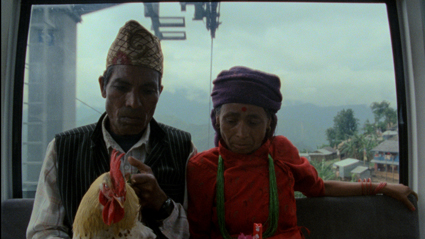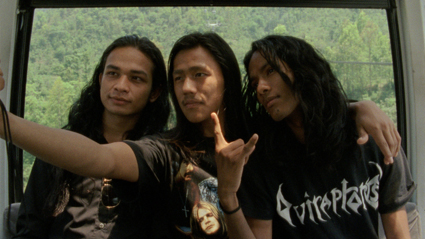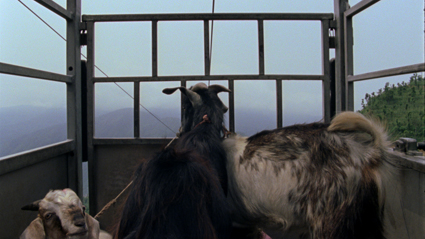Audiovision: Hyperreal sonics & breathing music
Phillip Brophy: Stephanie Spray & Pacho Velez, Manakamana

Manakamana, Stephanie Spray & Pacho Velez
Almost 25 years after the onslaught of post-colonialism in academic discourse—a well-intended yet passive-aggressive critique of preceding generations of colonisation and imperialism which shaped the concept of a ‘third world’—contemporary documentaries intent on capturing those terrains have rarely broken away from the leftist-humanist slant born of those ideologies.
While musicologists work similarly to televisual and documentary ethnographers and anthropologists, musicians and their audience rarely work this way. From Ska to Electro to Rai to Jungle to Reggaeton to Congotronics (to name obvious contenders), music has not once stopped performing as a living language, born of local conditions, shaped by transformative confluences and completely conscious of its shape-shifting identity. When industry and culture clash, it’s the stuff of people getting together and making noise despite the determining semantics of their chosen tools, instruments, processes and sounds. The resulting music dictates its own hybrid identity with its own voicing, no matter how incorrect, contradictory or unsuitable its appearance.
So what happens now when music-making and documentary practices intersect? Mostly, it’s the same old post-colonial lip service being voiced despite the styles employed. Openly problematising freshness comes from the efforts of the Sensory Ethnography Laboratory, an experimental yet institutional filmmaking venture and program established in 2007 at Harvard University. Its varied results are linked by a willingness to explore cine-doco-televisual modes of encoding and inscription which forward an excess of documented data (visual and/or aural) while attempting to refrain from narrational, discursive and/or determining modes of address and commentary. It’s a utopian impulse for sure—one born of the power of poetics overcoming didacticism—yet the after-effect of this slant on documentary practice has enhanced and accentuated how sound (and by inference, music) shapes the end results.

Manakamana, Stephanie Spray & Pacho Velez
Stephanie Spray & Pacho Velez’s Manakamana (2013) is possibly SEL’s most advanced example in this respect. The documentary is a suite of uninterrupted single-shots of one-way journeys in a cable-car strung high over hilly and terraced heights in Nepal, either to or from a Hindu temple at the uppermost stop of the ride. Each shot simply shows the car’s inhabitants (singles, duos and trios) sitting facing a fixed-tripod camera. Shot on Super-16mm but recorded in full and crisp digital audio, the inhabitants occupy most of the frame; we witness them observing everything we can’t fully see (beyond the layer of glass visible behind them), plus they often acknowledge the camera in a casual and nonplussed manner. It’s amazingly open in its procedure and its contents: the results are starkly experimental yet the means of production are thoroughly disclosed and evident. The surfeit of detail and the complexity of subtle inflections captured make for riveting viewing and auditing—the deliberately dumb automaton camera-work and the knowing tedium of its temporality seem to enforce rather than limit this.
Now, many critics have interpreted Manakamana in terms of ‘honesty,’ ‘truth’ and ‘reality’ due to the nature and conceit of its production. But I wonder if such knee-jerk support for ‘keeping-it-real’ documentary tropes misses the greater audiovisual complexity of the film. For many people, the absence of music and the removal of a narrational voice-over can create a ‘shock of the real’ while preventing them from realising how a documentary’s codes can determine their experience. In line with the SEL’s codes of practice, Manakamana is intent on exploring how an audience’s experience can be reconfigured by engaging with the documented material in a new and expanded way. And the locus of this activity is on the soundtrack.

Manakamana, Stephanie Spray & Pacho Velez
Firstly, the film crystallises the contradiction between visual and aural modes of inscription: its grainy patina collides with its hyperreal sonics. The closer you squint at its images projected large (in the 2014 Melbourne International Film Festival), the deeper you fall into the swimming grain of the film’s abstracting surface. But the closer you listen to the soundtrack, the more you perceive the complex networking of occurrences which comprise the real-time synchronous passage of time and space in each cable-car journey. Plus, one hears much activity equally beyond the camera frame and beyond the cable car. In an evocative gesture toward self-reflexivity, the cable car becomes a type of camera obscura, positioned to be embodied within the world while encoding its place within that world.
Secondly, inasmuch as the cable car is a camera obscura, it is also a recording booth. Its domain centres the spherical immersive experience of sound all around—especially in a suspended cable car high off the ground— and translates to us a similar ‘other-worldly’ experience of the depicted environment as one which floats the listener in sound’s totality. This is a supremely ‘non-screenic’ effect. The bulk of all cinematic effects is predicated on an illusory window-on-the-world, which in turn is derived from the sensation of situating an audience in a black void box to witness images which appear to come from a zone beyond/behind the screen. Conversely, Manakamana documents its sensory environment by situating the imaginary ear smack in the middle of the world it visually captures.
This ‘non-screenic’ effect is highlighted by the thunderous shuddering clackety-booms which intermittently occur when the suspension cable passes through the structural towers dotted along the cable car route. Rather than mute these moments or mix them down, the film fully captures the sensation of being jolted by these markers of the film’s cyclical journey. Sharp transients, whelps of bass and peaks in volume shake everything: the car, its inhabitants and the cinema itself, as the booms erupt the otherwise pastoral appearance of the film’s contemplative tone. But soon enough, one is accustomed to these jolts just as the on-screen passengers appear inured to their disruption, and the film synchronises to the inhabitants’ relaxed relation to their environment.

Manakamana, Stephanie Spray & Pacho Velez
But perhaps the most noticeable aspects of Manakamana’s soundtrack arise from the placing of music within this anthropological laboratory. From a trio of metal band members enthusiastically taking selfies, preening their hair while quoting/singing phrases of local folk songs from the radio, to what might be a father and son musical duo who say little but spend most of the time tuning their sarangi while playing a traditional song, the film powerfully captures the vibrancy of music as a lived language. The absence of preciousness with which these ‘characters’ breathe music while engaged in apparently oppositional activities proves how ‘second nature’ music can be, produced and experienced by musicians regardless of any contextualising or determining framework of its presentation. By the time we get to a cable car ride with five goats, one starts to even appreciate the animals’ responsive bleating as a meld of music, language and sound.
In a contemporary climate wherein everyone and everything is desperate to humanise, well, everyone and everything, Manakamana doesn’t simply provide momentary respite from this pathetically saturated realm of utopian well-wishing: it actively, materially and formally foregrounds how a commitment to an informed aesthetic practice can unleash a broader and more encompassing politics of representation. Watching the movie will only reinforce limp leanings towards the very humanism the film potentially combats. Listening to it subjects us to audiovisual incidents and environments that circumnavigate illusory humanism by instilling one with a breathtaking sense of our own insignificance.
–
Manakamana was the winner of the Golden Leopard award, Filmmakers of the Present, Locarno Film Festival
Stephanie Spray & Pacho Velez, Manakamana, 2013, 118 mins, Melbourne International Film Festival, 7, 10 Aug
RealTime issue #123 Oct-Nov 2014 pg. 17






